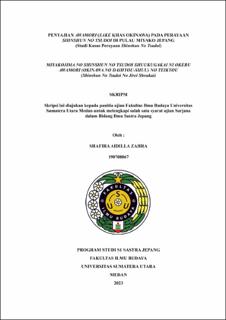| dc.description.abstract | This research focuses on two main topics of discussion, namely the annual New Year celebration in Japan, specifically in the Okinawa region of Miyako Island, Japan called 'Shinshun No Tsudoi' and its relation to Okinawa's specialty sake called 'Awamori'. The purpose of the research is to describe the performance of Awamori presentation at Shinshun No Tsudoi celebration and the function of the tools used in the presentation of Awamori. Shinshun No Tsudoi is systematically the same celebration as Shinnenkai. The name of the celebration is the only thing that is different about it. Awamori is an alcoholic drink that is distilled using rice from Thailand, which historically entered Japan's Okinawa Island region through international trade during the Ryukyu Kingdom. This research uses descriptive, qualitative and translation writing methods to develop the data obtained. The data of this research is also obtained from the author's observation of Shinshun No Tsudoi and Awamori celebration directly in Miyako island, Okinawa, Japan, also through respondents and literature study. The result of this research shows that Awamori is a symbol of the main culture in Shinshun No Tsudoi celebration in Miyakojima; the main role of Awamori in the celebration, especially the performance in the implementation of Taruzake Kagamibiraki activities, represents a meaning that is so meaningful for all aspects in Miyakojima. In addition, Awamori at Miyakojima's Shinshun No Tsudoi celebration is served using 8 different tools and their functions, namely the Iwaidaru as a sake barrel, a wooden mallet (kidzuchi) to hit the lid of the Iwaidaru, a ladle as an intermediary for Awamori from the Iwaidaru to the kettle, kettle as the container of Awamori served to guests, glass for drinking Awamori, ice cube container, capitan and its stirrer for the optional addition of ice cubes, Masu (container for drinking Awamori Taruzake) as the traditional place to drink Awamori, and wooden cup as the intermediary of Awamori from Iwaidaru to Masu. | en_US |



